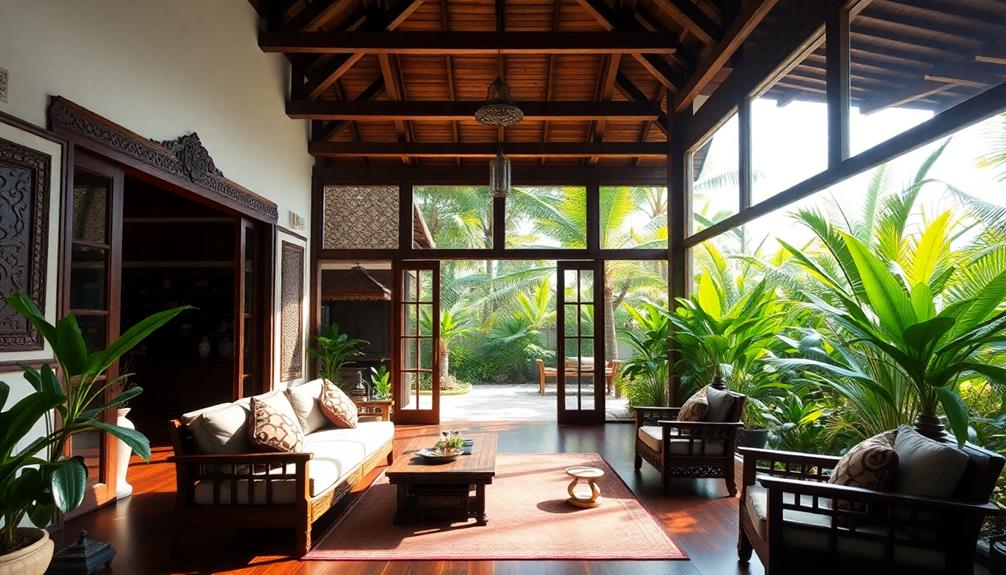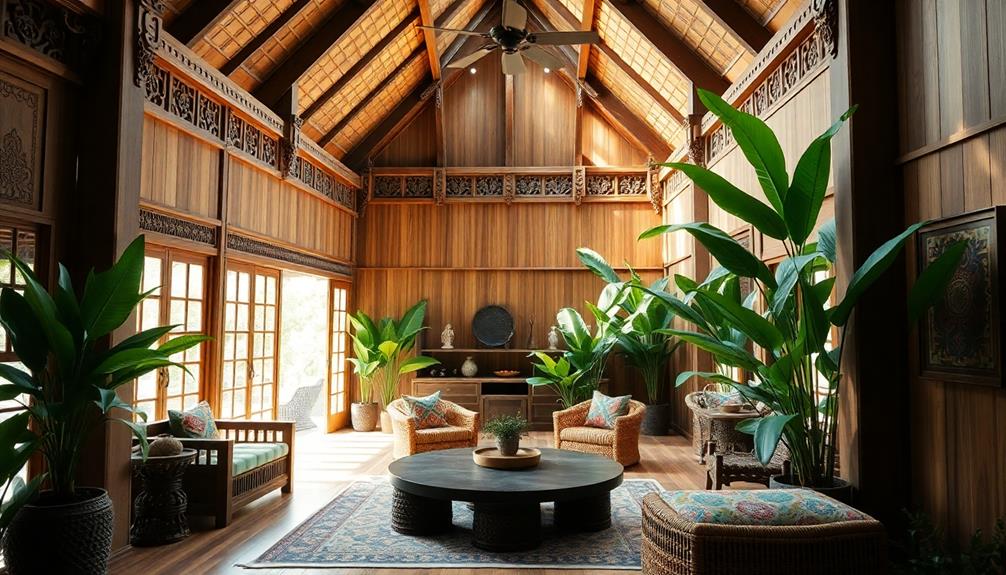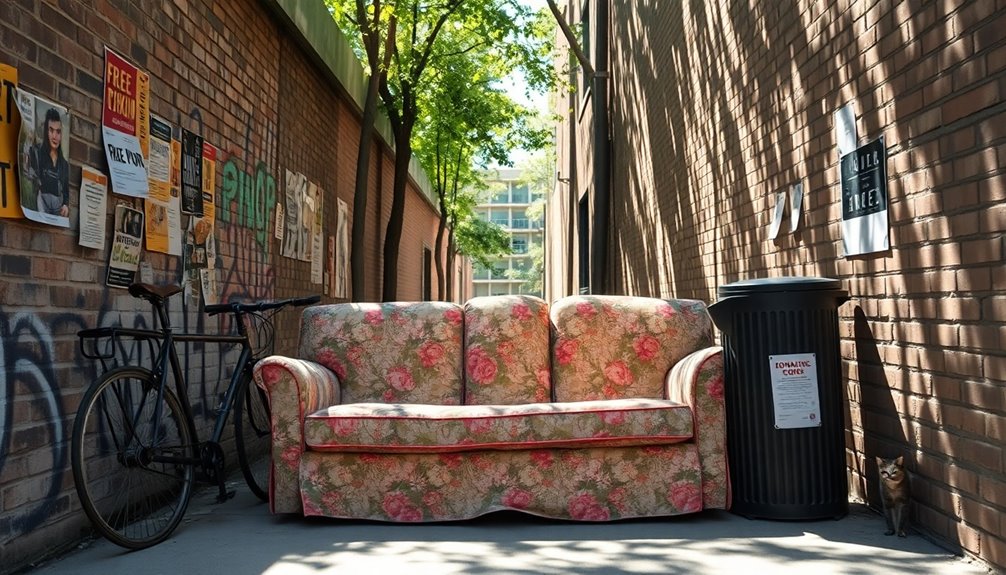Traditional Indonesian house interiors provide a perfect combination of timeless beauty and modern functionality. The incorporation of natural materials such as teak and bamboo adds warmth and sustainability to the home. Earthy tones paired with vibrant colors create a dynamic atmosphere, while intricate carvings showcase the rich cultural heritage. Open floor plans effortlessly connect indoor and outdoor spaces, enriching the overall living experience. By integrating traditional craftsmanship and environmentally friendly practices, a welcoming and harmonious environment can be achieved. For those interested in personalizing these designs, there is much more to discover! To truly make your Indonesian house interior design unique, consider incorporating handwoven textiles and unique artisanal decor that reflect local craftsmanship. These elements highlight authenticity while allowing you to showcase your individual style. Indonesian house interior design beautifully blends tradition with modern living comforts, focusing on natural elements and cultural heritage.
Key Takeaways
- Traditional Indonesian interiors utilize natural materials like teak and bamboo, promoting durability and warmth while being environmentally sustainable.
- Earthy tones combined with vibrant hues reflect Indonesia's landscapes, enhancing the ambiance of modern spaces.
- Cultural motifs through intricate carvings and handcrafted elements preserve local heritage and add unique character to interiors.
- Open floor plans and large windows create seamless indoor-outdoor connections, fostering social interaction and tranquility.
- Combining contemporary furniture with traditional styles allows for a modern aesthetic while honoring Indonesia's rich cultural heritage.
Key Features of Indonesian Interiors

When you step into a traditional Indonesian interior, you're immediately struck by the warmth and authenticity created by natural materials like teak, bamboo, and rattan.
These elements not only provide durability but also foster an inviting atmosphere, perfect for modern living. The use of vibrant colors and intricate patterns, often found in Indonesian decorative pillows, enhances the overall ambiance, making spaces feel more dynamic and culturally rich.
You'll notice intricate carvings and traditional motifs that reflect local culture and mythology, enhancing the aesthetic appeal of furniture and architectural features.
The color palettes in these interiors typically embrace earthy tones, complemented by vibrant hues that echo Indonesia's diverse landscapes and rich cultural heritage.
Open floor plans are common, promoting social interactions and enhancing airflow, while large windows or sliding doors seamlessly integrate outdoor spaces, blurring the lines between inside and out.
Additionally, traditional Balinese art and handcrafted décor items, such as textiles and ceramics, add depth to the design, enriching the overall experience.
Cultural Significance in Design

When you look at traditional Indonesian house interiors, you'll notice how symbolism weaves through every element, from intricate carvings to color choices.
The use of vibrant decorations, such as Indonesian decor masks, further enhances the cultural richness of the space.
This craftsmanship not only showcases local artistry but also preserves cultural heritage, connecting you to the stories and beliefs of the community.
Understanding these layers enriches your appreciation of the space and its significance.
Symbolism in Interior Elements
Throughout Indonesia's diverse regions, traditional house interiors are rich with symbolism, reflecting the cultural narratives and spiritual beliefs of the people. The intricate carvings you see often tell stories of local folklore, adding depth to the design. Using natural materials like bamboo and teak not only enhances beauty but symbolizes a strong connection to the earth and sustainability.
Incorporating specific colors and patterns in textiles, such as batik, embodies meanings associated with prosperity, protection, or social status, showcasing your identity and values. The arrangement of furniture follows principles of harmony and balance, influenced by Feng Shui, emphasizing energy flow in your daily life.
Here's a brief overview of key symbolic elements:
| Element | Symbolism | Cultural Significance |
|---|---|---|
| Intricate Carvings | Stories of folklore | Connection to heritage |
| Natural Materials | Sustainability and earth | Importance of nature |
| Textiles | Prosperity and social status | Reflection of identity |
| Furniture Arrangement | Harmony and balance | Energy flow in living spaces |
| Religious Elements | Spirituality and community | Daily life integration |
Craftsmanship and Cultural Heritage
Craftsmanship in traditional Indonesian house interiors showcases a profound cultural heritage that reflects the skills and values of local artisans. You'll notice intricate wood carvings and handcrafted elements that embody the craftsmanship passed down through generations. These designs often feature cultural motifs, connecting you to the rich history and identity of the region.
Additionally, vibrant artistry is prevalent in decorative elements such as Indonesian decor masks, which enhance the overall aesthetic of the space and tell stories of local traditions traditional artistry.
Natural materials like teak, bamboo, and rattan play a vital role in these interiors, emphasizing Indonesia's abundant resources and a deep bond with the land. Each element is thoughtfully chosen, as they not only enhance aesthetic appeal but also promote sustainability and comfort in your living space.
Moreover, many traditional interiors incorporate symbolic colors and designs that express spirituality, community, and harmony with nature. This cultural significance enriches your environment, weaving meaningful narratives into the fabric of daily life.
It's also essential to recognize that the layout of traditional homes fosters communal living and social interaction, reflecting values of togetherness and family bonds.
Blending Indoor and Outdoor Spaces

In traditional Indonesian homes, you'll notice how seamlessly indoor and outdoor spaces blend together. Expansive verandas, large windows, and natural materials create a harmonious environment that encourages outdoor living.
This design philosophy not only enhances airflow and light but also promotes the use of natural materials like wood and stone to create a calming atmosphere.
Seamless Transition Techniques
Seamless shifts between indoor and outdoor spaces are essential for creating a harmonious living environment in traditional Indonesian homes. You can achieve these seamless changes by incorporating large glass doors that invite natural light and air into your living areas. This design choice allows the boundaries between indoor and outdoor spaces to blur, fostering a sense of tranquility and connection to nature.
Additionally, the use of vibrant colors in decor can enhance this interaction, reflecting the Bali interior design ideas that celebrate the beauty of nature.
Utilizing open floor plans enhances this fluidity, promoting social interaction and making it easy to enjoy the outdoors from the comfort of your interior. Imagine hosting gatherings where the lush gardens and courtyards become an extension of your living space.
The strategic placement of these green areas, combined with water features such as ponds or fountains, not only adds aesthetic value but also enriches the overall ambiance.
Incorporating natural materials like bamboo and teak in both indoor and outdoor settings reinforces visual continuity and strengthens the bond with the surrounding environment. By embracing these seamless change techniques, you'll create a serene and inviting atmosphere that beautifully melds modern living with traditional Indonesian charm.
Nature-Inspired Design Elements
Nature-inspired design elements play an essential role in blending indoor and outdoor spaces in traditional Indonesian homes. You'll notice that large glass doors and open layouts enhance airflow and natural light, creating a seamless connection between your living areas and the beauty of nature outside.
This approach mirrors the modern tropical aesthetics in Bali, where lush greenery and natural materials are prominently featured. By incorporating indoor gardens and water features, you foster a tranquil atmosphere that connects you with the surrounding environment.
Using natural materials like bamboo, teak, and stone not only reflects the rich cultural heritage of Indonesia but also promotes sustainability and harmony with nature. These materials help create warm, inviting spaces that echo the beauty of the outdoors.
You can also enhance your interiors with vibrant plant life, bringing a touch of the lush landscape inside.
Additionally, traditional Balinese art can be integrated within your home, adding a unique aesthetic appeal that reinforces the theme of nature-inspired living.
As you embrace these elements, you'll find that your space feels more connected to the outdoors, encouraging relaxation and social interaction. This harmonious blend of indoor and outdoor environments truly captures the essence of traditional Indonesian design.
Enhancing Outdoor Living
Creating a harmonious outdoor living space enhances the overall ambiance of your home. Traditional Indonesian architecture masterfully blends indoor and outdoor environments, allowing for natural lighting and fresh air to flow freely. To achieve this, consider incorporating expansive verandas and large glass doors that act as a seamless connection between spaces.
You can also enhance your outdoor living spaces by adding unique architectural features such as ponds or fountains. These water elements not only serve as tranquil focal points but also connect the interior and exterior, promoting relaxation. Surrounding your home with lush tropical gardens filled with vibrant plants will foster a serene atmosphere, perfect for socializing or unwinding.
Here's a quick guide to enhancing your outdoor living spaces:
| Feature | Benefits | Tips |
|---|---|---|
| Expansive Verandas | Seamless connections | Use large glass doors |
| Water Features | Tranquility and focal points | Consider ponds or fountains |
| Natural Materials | Blend with landscape | Utilize bamboo and teak |
| Comfortable Seating | Ideal for entertaining | Add shaded areas |
| Lush Gardens | Encourage relaxation | Incorporate vibrant plants |
Sustainable Materials and Practices

Embracing sustainable materials and practices is at the heart of traditional Indonesian house interiors. You'll find that materials like bamboo, teak, and coconut wood aren't just durable; they're renewable resources that greatly minimize environmental impact.
These materials are often featured in traditional Indonesian housing, showcasing their beauty and sustainability. By choosing these sustainable materials, you contribute to a healthier natural environment.
Incorporating natural fibers such as rattan and jute into your furniture and decor promotes eco-friendly practices while adding rich texture and warmth to your space.
Traditional designs often feature open-air layouts, allowing for natural ventilation and reducing the need for artificial cooling systems, which enhances energy efficiency.
You might also consider integrating rainwater harvesting systems and passive solar design into your home. These methods not only support sustainable water management but also optimize energy use, further aligning your living space with eco-friendly principles.
Additionally, using locally sourced materials sustains local economies and curbs transportation emissions, reinforcing your commitment to sustainable living.
Craftsmanship and Handcrafted Elements

Sustainable materials and practices lay the groundwork for the beauty found in traditional Indonesian house interiors, where craftsmanship truly shines. The intricate wood carvings you see often tell tales of local mythology, culture, and history, making each piece a unique work of art. Handcrafted elements, like woven textiles and batik fabrics, enhance the aesthetic appeal while supporting local artisans and preserving traditional crafting techniques.
| Element | Description |
|---|---|
| Wood Carvings | Intricate designs reflecting culture and mythology. |
| Woven Textiles | Handcrafted fabrics that add warmth and texture. |
| Rattan Furniture | Durable and sustainable seating options made locally. |
| Hand-painted Ceramics | Unique decorative pieces celebrating artistic heritage. |
| Traditional Masks | Cultural artifacts that personalize the space. |
Bespoke furniture crafted from locally sourced materials like teak and bamboo not only emphasizes durability but also showcases a commitment to environmental consciousness. The artisanal finishes and handcrafted details in these interiors create an authentic atmosphere, bridging the gap between traditional design and contemporary living, while celebrating Indonesia's rich artistic heritage.
Color Palettes and Natural Accents

A rich tapestry of color palettes and natural accents defines traditional Indonesian house interiors, inviting you into a space that feels both vibrant and grounded. The earthy color palette incorporates shades of brown, beige, and green, reflecting the stunning landscapes of the Indonesian Islands. These hues create a serene backdrop that complements the lively accents found throughout the home.
Additionally, the use of Indonesian decor masks can enhance the cultural storytelling aspect within these interiors, adding a unique touch to the ambiance.
You'll often spot vibrant tones inspired by tropical flora, like deep reds, yellows, and blues, which serve as striking focal points against the calmer shades. Natural accents such as wooden beams, bamboo furnishings, and stone elements further enhance this connection to nature, fostering a warm, inviting atmosphere.
Textiles like batik and ikat fabrics add depth and texture, showcasing bold patterns that celebrate Indonesia's rich cultural heritage.
When you incorporate natural light through large windows and open spaces, you'll notice how it transforms the color palette, shifting perceptions of color throughout the day. This dynamic interplay between light and color makes the interiors feel alive and engaging, seamlessly blending traditional elements with contemporary design to create a unique living environment.
Tips for Modernizing Traditional Styles

Modernizing traditional Indonesian styles involves blending the rich cultural elements with contemporary aesthetics, creating a harmonious living space.
To achieve this, start by incorporating contemporary furniture with clean lines alongside traditional pieces. This unique blend not only honors both styles but also enhances the overall interior design of your modern home.
Consider emphasizing outdoor living areas, inspired by tropical villa plans, to further enrich your space and connection to nature.
Opt for a neutral color palette inspired by natural materials, which allows traditional textiles and artwork to shine as focal points.
Replace heavy drapery with lightweight fabrics or sheer curtains to let in natural light, especially with large windows, creating an open and airy atmosphere that reflects modern design principles.
Integrate modern technology discreetly, such as built-in lighting and sound systems, to maintain the traditional feel while providing contemporary conveniences.
Emphasizing open floor plans is essential, as they promote fluid movement and social interaction, mirroring the communal nature of traditional Indonesian homes while adapting to your modern lifestyle.
Frequently Asked Questions
What Are the Common Furniture Styles in Traditional Indonesian Homes?
In traditional Indonesian homes, you'll often find wooden furniture, intricately carved pieces, and bamboo elements. Styles vary by region, but you can expect to see vibrant textiles and functional designs that reflect cultural heritage throughout. Many homes are built on stilts, with high ceilings to allow air circulation in the tropical climate. Some *Indonesian traditional house names* include the *Rumah Joglo* from Java and the *Rumah Gadang* from West Sumatra, each with its own unique architectural style and cultural significance. These houses are often designed with communal spaces in mind, reflecting the importance of family and community ties in Indonesian life.
How Can I Incorporate Indonesian Textiles Into My Decor?
You can incorporate Indonesian textiles by using batik cushions, sarongs as table runners, or ikat curtains. Mixing these vibrant patterns with neutral tones creates a balanced, inviting space that reflects Indonesia's rich cultural heritage.
Are There Specific Plants Associated With Indonesian Interior Design?
Yes, you can use specific plants like monstera, philodendron, or snake plants to enhance your Indonesian-inspired decor. These green beauties not only add freshness but also reflect the natural, vibrant essence of Indonesian design.
What Lighting Options Complement Traditional Indonesian Interiors?
To complement traditional Indonesian interiors, you'll want to use warm, ambient lighting. Consider pendant lamps with intricate designs, bamboo fixtures, or lanterns. These options enhance the natural beauty and cultural richness of the space.
How Do I Maintain Traditional Indonesian Furniture?
Did you know that over 80% of traditional furniture lasts a lifetime with proper care? To maintain your traditional Indonesian furniture, regularly dust it, use a soft cloth, and apply wood polish to preserve its beauty.
Conclusion
Incorporating traditional Indonesian elements into your modern space can create a unique and inviting atmosphere. Did you know that homes designed with natural materials can reduce energy costs by up to 30%? By embracing the timeless beauty of Indonesian interiors, you not only enhance your living environment but also promote sustainability. So, whether you're blending indoor and outdoor spaces or choosing handcrafted decor, you'll find that these designs offer both aesthetic appeal and practical benefits.









